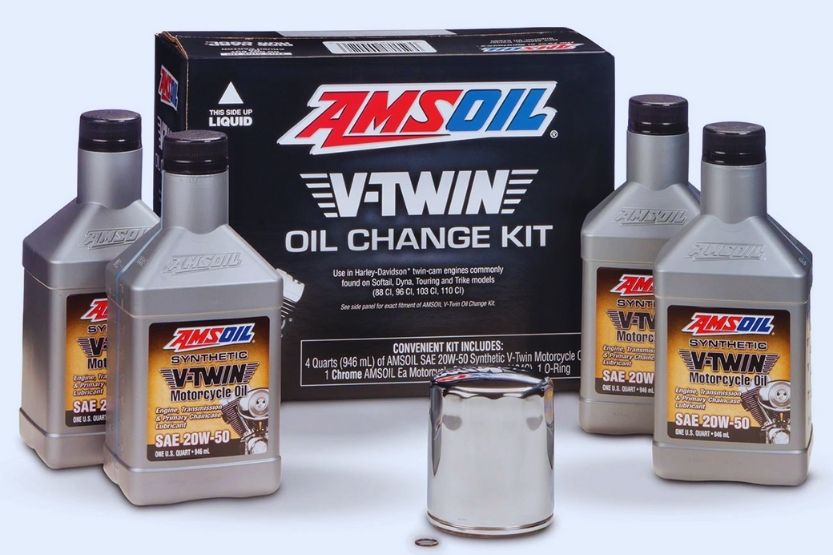Two of the leading names in the synthetic oil market are Amsoil and Royal Purple. But which of these lubricants offer the best quality and value for consumers? Let’s put these oils to the test and settle once and for all, which between Amsoil and Royal Purple is the best one for your engine.
Amsoil and Royal Purple are two of the finest lubricants in the market. But while both have their merits, scientific testing has concluded that Amsoil is the best motor oil brand. This is in terms of fuel efficiency, engine protection, cleaning power, and heat and cold performance.
Read on to learn more about Amsoil and Royal Purple, including their features, advantages, and disadvantages.
Amsoil Vs Royal Purple

Royal Purple and Amsoil are two of the best lubricants in the market. Both have their merits, but scientific testing states that Amsoil is the best motor oil brand. This is in terms of fuel efficiency, engine protection, cleaning power, and heat and cold performance.
Their various features are reviewed to find out whether Amsoil or Royal Purple is the better motor oil brand.
This includes taking their pros and cons into consideration. They are then subjected to a series of tests. This way, we could measure how well they perform under extreme temperature and pressure conditions.
More About Amsoil
Amsoil is a key figure in the synthetic oil industry. It was the first synthetic oil to meet the American Petroleum Institute (API) requirements in 1972. The business has a “The First in Synthetic” slogan. They have since become one of the world’s largest manufacturers of synthetic motor oil.
Features
The main features of Amsoil include the following:
- Rust-resistant properties
- Provides higher viscosity
- Increased clutch performance efficiency
Amsoil Product Review
Let’s talk about Amsoil based on the following factors:
- Performance
- Engine Protection
- Rust Resistant Properties
- Enhanced Alkalinity
1. Performance
Performs Two Times Better Than Other Synthetic Lubricants
Although Amsoil synthetic motor oil is costly, it performs two times better than other synthetic lubricants.
Extra Security Layer with Heat-resistant Properties
It has an extra security layer possessing heat-resistant properties. These remain constant even while the engine works on overdrive. It helps to reduce fuel consumption when driving under rough conditions.
Provides Car with Optimal Protection in Extreme Temperatures
Amsoil motor oil provides your car with optimal protection in extreme temperatures. Also, it has a viscosity that makes the oil flow and easy to pump during the cold morning. At the same time, it protects the engine from wear and tear that may occur while you are starting it.
2. Engine Protection
Protects Engine Even When It Heats up
Amsoil motor oil will protect your engine even when it heats up after driving long distances. Oil loses its protection properties when it disintegrates in high temperatures. This then exposes the engine to wear and tear and reduces engine life.
Extended Oil Drain Intervals
Amsoil synthetic oil doesn’t dissipate in high temperatures. It grants you extended oil drain intervals and saves you a lot in expenses.
Another problem that often occurs during heavy driving is reduced clutch performance. This results from friction between the clutch discs and the plates.
Reduces the Friction Between the Disc and Plates
Amsoil motor oil reduces the friction between the disc and plates to address said problem. Its enhanced lubricity reduces metal-to-metal friction in the engine and protects it from wear and tear.
3. Rust Resistant Properties
Comes with Additive Rust-resistant Properties
Amsoil synthetic oil comes with additive rust-resistant properties. These keep your engine free from rust formation even while it is idle. Over time, a crust layer may develop on different vehicle parts. This may eventually lead the compression, roller bearing, and other components to fail.
Helps Maintain Mechanical Flexibility
Amsoil’s rust-resistance capability addresses this and improves engine performance. It helps maintain mechanical flexibility. Most importantly, it gives you a smooth ride throughout the year. Its cleaning properties eliminate dirt and deposits as the oil circulates in the engine.
4. Enhanced Alkalinity
When oil burns in the engine, this may result in the formation of acids which cause metals and other engine parts to corrode.
Helps Deal with the Acids in the Engine
This reduces the engine’s lifespan. Amsoil motor oil comes with enhanced alkalinity, which helps deal with the acids in the engine. It minimizes metal corrosion and ensures a longer engine lifespan.
Can Withstand Extreme Temperatures
Amsoil motor oil can withstand extreme temperatures. It holds up rather well under extended drain levels. Performing well under extreme pressure conditions, it acts as a gear lubricant. It protects the engine against extra-pressurized activities.
Surpasses the Warranty Requirements of Most Car Manufacturers
Also, Amsoil synthetic oil meets or surpasses the warranty requirements of most car manufacturers. This means that your warranty won’t be voided in case something happens.
Pros and Cons of Using Amsoil
Pros
- Performs well under extreme temperatures
- Allows the engine to have a smooth running
- Provides advanced protection from wear and tear
- Enables the clutch to work efficiently
- Protects against rust and corrosion
- Cleans sludge and deposits in the engine to keep it healthy
- Extends the life of the engine and other internal components
- Offers better fuel economy
- Provides a secured transmission
- Protects the chain cases
- Does not void warranty
Cons
- Does not perform well when mixed with other oils
- Drain interval does not work for altered or modified engines
More About Royal Purple

Hailing from North America, Royal Purple meets all industry requirements for high-quality synthetic motor oil. Its outstanding performance makes it the go-to lubricant among most car manufacturers and owners alike.
Features
The main features of Royal Purple include the following:
- Fully compatible with other synthetic and mineral oils
- Synerlec technology incorporated for high performance
- Anti-rust agent
- Improves performance of rusty engines
- Keeps internal components clean and provides long-term protection
Royal Purple Product Review
Let’s talk about Royal Purple based on the following factors:
- Compatibility with Other Conventional and Synthetic Oils
- Versatility
- Superior Additive Technology
- Performance Under Extreme Temperatures
1. Compatibility with Other Conventional and Synthetic Oils
Consists of Base Oils and Additive
Royal Purple synthetic motor oil consists of base oils and additives, including ethanol. This makes it compatible with other conventional and synthetic oils.
Best to Use Alone
However, mixing Royal Purple with other lubricants may affect its performance and durability. So it is best to use it alone in the engine to get the best results.
Fortunately, there are no special procedures needed to upgrade to Royal Purple. Just drain your current oil out, and then add Royal Purple in.
2. Versatility
Can Be Used in Both New and High Mileage Engines
The versatility of Royal Purple motor oil allows it to be used in both new and high mileage engines. To use Royal Purple in a new engine, you can wait until the manufacturer’s first scheduled oil change.
Or, you can wait after driving 2,000 miles for a gasoline engine and around 10,000 miles for a diesel engine.
Drain Oil Every 5,000 Kilometers
Drain your oil every 5,000 kilometers if you’re using Royal Purple on a high mileage engine. This will allow the oil enough time to clean up the oil deposits inside the engine. Afterward, you may start to extend the drain intervals.
3. Superior Additive Technology
Enhances Engine Performance and Protection
Royal Purple motor oil comes with superior additive technology. This enhances engine performance and protection.
Manufactured with Anti-wear Compounds
In particular, its lubrication is manufactured with anti-wear compounds. These limit friction damage on crucial engine components. It then provides better protection and increased durability for your engine.
Contains Additives That Help Keep the Engine Clean
Royal Purple also contains additives that help keep the engine clean. It collects and eliminates all sludge and deposits while the engines flow. In addition, its rust-resistant properties prevent rust from forming even when your engine is idling.
4. Performance Under Extreme Temperatures
The thermal properties of Royal Purple synthetic oil enable it to perform well in severe temperatures. This includes facilitating an easy startup in cold weather.
Has Patented Technology Additives
It has a suitable viscosity rating of 20 in cold temperatures and 50 in normal temperatures. Also, it has patented technology additives that provide an extra layer of protection. It helps keep the engine cool while maintaining proper temperature stability and oxidation.
These special properties make Royal Purple more expensive compared to other motor oils. But the benefits make up for its high price.
Again, Amsoil vs Royal Purple – Which is better? Amsoil and Royal Purple are both excellent lubricants. However, according to tests, Amsoil is better than Royal Purple in fuel efficiency, engine protection, cleaning power, and heat and cold performance.
Pros and Cons of Using Royal Purple
Pros
- Compatible with other conventional and synthetic oils
- Offers better fuel efficiency in new and old vehicles
- Versatile and provides superior protection for both diesel and gasoline engines
- Enhanced protection against engine wear and tear
- Enhanced protection from corrosion caused by acids
- Performs well under extreme temperatures and weather conditions
- Improves fluid consistency and viscosity rate
Cons
- Costs more than other oils
- The black bottle makes it hard to estimate the amount of oil inside it
Amsoil Vs Royal Purple – 5-Stage Test

The test undergone by Amsoil and Royal Purple includes five stages. They are the following:
- Four Ball Wear Test
- Cold Cranking Viscosity Test
- Noack Volatility Test
- TEOST (Thermo-Oxidation Engine Oil Simulation Test)
- TBN (Total Base Number Test)
1. Four Ball Wear Test
Shows the Motor Oils’ Wear Preventive Qualities in Sliding Contact
This test will show the motor oils’ wear preventive qualities in sliding contact under controlled test conditions. Experts pressed a metal ball while pouring it with the test oil. Then, they turn it down between three individual balls arranged in a triangle.
The objective is to cause less harm to the ball under the shower of a particular oil. In which case, the oil does a better job in preventing metal wear.
Amsoil Had a Minor Wear Scar
Out of four different motor oils tested, Amsoil comes first. It had a minor wear scar of below 0.44 mm. At a very close figure to that, Royal Purple lands in fourth place right behind the other two oils. They were Lucas and Valvoline Synpower, respectively.
Amsoil beats Royal Purple by just a narrow margin. But when it comes to engine protection, even the smallest scratch could lead to greater damage in the long run.
2. Cold Cranking Viscosity Test
A Cold Engine Affects the Engine Oil’s Viscosity
Most cases of engine wear occur right when you are beginning to start your vehicle. When the engine goes cold after an extended period of idleness, it could affect the stickiness and thickness of the engine oil. The thicker the oil gets, the harder it becomes to pump it through the engine.
Frosty Wrenching Thickness Test involves pouring motor oil into a Cascade cooling machine. The brands tested are the following:
- Amsoil
- Mobil 1
- Royal Purple
- Walmart
Before the test, experts chilled the motor oils at -30° C over 24 hours.
Amsoil Had the Lowest Viscosity At Below 4000
Amsoil showed the lowest viscosity at below 4000. Royal Purple’s viscosity is a little higher at above 6000. This shows that Amsoil proves to have a better low-temperature performance than Royal Purple.
3. Noack Volatility Test
Determines How Much Mass a Motor Oil Loses When Vaporized
The Noack Volatility Test or the Noack Instability Test determines how much mass a motor oil loses when molecules are vaporized through the process of volatilization.
Synthetic oils like Amsoil and Royal Purple have important molecules that enhance the engine’s performance.
A number of these molecules may burn inside the cylinders. They evaporate at extremely high temperatures via crankcase ventilation.
Volatilization Results to Thicker and Heavier Oil
This results in a thicker and heavier oil with lower viscosity. This will increase the fuel and oil consumption of your vehicle. It reduces fuel economy and causes dark smoke and wear and tear.
Over time, experts heated the lubricants to 150°C, boiling their lighter molecules to yield weight loss. This is expressed as a percentage of the evaporated oil.
The lower the percentage is, the better fuel economy and resistance to volatilization becomes. The maximum percent volatilization rate should be below 15%.
Amsoil Has the Lowest Percentage Loss at 5.70%
Amsoil has the lowest percentage loss at 5.70%, while Royal Purple comes at 11.20%. For the third test in a row, Amsoil comes out on top.
4. TEOST (Thermo-Oxidation Engine Oil Simulation Test)
Rate at Which Elements Are Deposited in Various Parts When the Oil Burns Off
There’s an important motor oil quality that most people take for granted. It is the rate at which elements are deposited in various parts when the oil burns off.
Deposits End up on Vital Engine Components
Motor oils burn off at high temperatures. They form deposits that may end up on vital engine components, including:
- Turbos
- Fuel injectors
- Others
These deposits can block the fuel injector. In which case, they will affect its spray pattern. It will reduce combustion efficiency and cause the engine to lose power slowly.
Stimulates Turbocharger Operating Conditions
The TEOST Test involves simulating turbocharger operating conditions. This is to indicate the highest temperature deposit-forming properties of engine oil. Motor oil specifications recommend that the limit deposit formation of 5W-30-rated oils must be cut to 30 mg or less.
At 25.4 mg, Royal Purple sticks relatively close to the limit. On the other hand, Amsoil scores again with a total deposit weight of 7.0 mg.
5. Total Base Number Test (TBNT)
Oil Produces Acidic Elements That Causes Corrosion
The oil produces acidic elements while the engine is running. These promote corrosion, harming the engine and reducing its lifespan. Aside from this, rust blocking the vital valves and vents will reduce engine performance.
Measures the Oil’s Ability to Clean the Engine
The TBN Test or the Add-up to Base Number Test measures the oil’s ability to clean the engine. Also, it neutralizes the acidic components produced during a regular engine run.
Manufacturers made the Amsoil and Royal Purple engine oils with the basic components that reduce or neutralize the acidic elements and their effects. The difference lies in quantity. It also lies in how the basic alkaline component is blended to deal with the acid problem effectively.
The TBN test measures which oil’s reserve alkalinity better regulates the acids produced in the combustion process. The higher the TBN value is, the better the basic component is blended. This then increases engine protection.
Amsoil Takes First Place with the Highest TBN Value
In a TBN Test of ten sample engine oils, Amsoil takes first place with the highest TBN value of 14 units. Royal Purple is in seventh place with nine units. This means that, of the two main lubricant brands we are reviewing, Amsoil ensures your engine has a longer lifespan than Royal Purple.
Which Is the Better Engine Oil? Amsoil Vs Royal Purple
The result appears to be unanimous—Amsoil aces all five tests to emerge victorious as the best synthetic motor oil in the market. With 40 years of experience, this pioneer in the lubricant industry continues to get better with age.
However, this shouldn’t mean that Royal Purple isn’t any good. It features improved fuel efficiency and outstanding rust and corrosion-resistant properties.
This means that it does perform well in its own right. It is especially well-suited for stressed engines requiring reduced friction and better oiling support.
At any rate, Amsoil and Royal Purple meet or exceed API industry standards at any rate. This proves that each brand produces high-quality products.
Frequently Asked Questions – Amsoil and Royal Purple
Here are several frequently asked questions that can help you decide if Amsoil or Royal Purple is the ideal product for you:
What Is Amsoil Synthetic Motor Oil?
Amsoil is a full synthetic engine oil. This means that it is made in a laboratory using a combination of polymers. It does not have any trace of crude oil.
Is Royal Purple a Full Synthetic Motor Oil?
Royal Purple is a fully-synthetic high-performance premium quality motor oil. It helps improve the performance of an engine. Also, it provides better wear protection than other conventional and synthetic motor oil blends.
What Is Amsoil Motor Oil Made From?
Amsoil motor oil is made from synthetic base oils manufactured to an advanced performance level. It is chemically engineered with a specified molecular composition that is central to the performance properties required for lubricants.
How Is Royal Purple Motor Oil Made?
Royal Purple is made from a synthetic oil blend. It is also made from the company’s proprietary synthetic additive technology Synerlec. This technology greatly reduces heat and wear in the engine.
Conclusion – Amsoil Vs Royal Purple
With so many motor oil options available to you, it is important to know which brand bests protects your engine and enhances its performance. Amsoil and Royal Purple are two of the finest lubricants in the market.
But while both have their merits, scientific testing has concluded that Amsoil is the best motor oil brand based on fuel efficiency, engine protection, cleaning power, and heat and cold performance.
Read next:



![Magnaflow Vs Flowmaster Exhaust System [Which Is Better?] magnaflow vs flowmaster](https://roadsumo.com/wp-content/uploads/2021/05/magnaflow-vs-flowmaster-150x150.jpg)



![Read more about the article How Much Is an Oil Change at Valvoline? [Valvoline Oil Change Prices]](https://roadsumo.com/wp-content/uploads/2021/05/how-much-is-an-oil-change-at-Valvoline-300x200.jpg)

